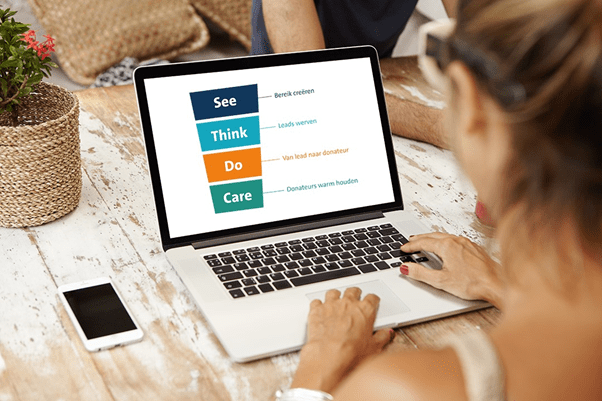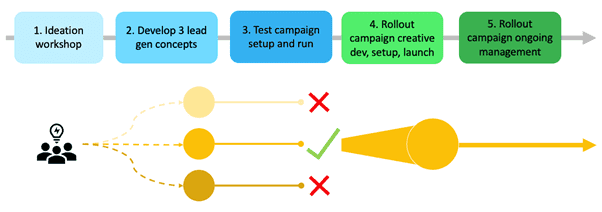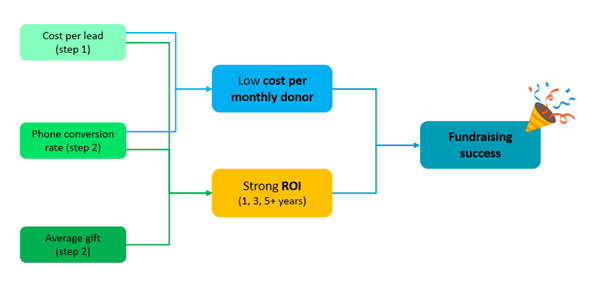Two-step campaign: how to make your charity grow
Leads are like little seeds. What you really want is for them to grow into loyal donors. That is where the two-step campaign comes in.
In this article, you will read how to set up a two-step campaign, test out ideas and ensure your campaign is a success, so that even minor leads grow into flourishing donors. A two-step campaign involves more than merely collecting contact information; it is about building real relationships.
Written by Samira Huibregtse, online marketer at Mindwize
From lead to loyal donor
Before I can show you what a two-step campaign might look like, you must first know about the journey that potential donors make. Unsurprisingly, this is known as the donor journey.
- See phase — Potential supporters see your advertisements
- Think phase — They start to think: Hmm, maybe I should take a look at this organisation’s website. On your website, you offer them something tangible, such as an interesting brochure they want to download or a petition they are happy to sign.
- Do phase — After downloading the brochure or signing the petition, your leads end up in a strong email journey. It is designed to help them discover why their contribution is so important, so they will eventually make a donation.
- Care phase — Of course, you don’t want people to make just one donation. This phase is therefore about investing in long-term relationships with your donors. This ensures they keep coming back to you to make more (and hopefully bigger) donations.

The donor journey, from lead to loyal donor
Your two-step campaign from start to finish
Now that you understand the journey a potential donor goes on, we can examine how to tailor your two-step campaign to this journey.
- During the first part of your two-step campaign, you focus on generating leads (the See and Think phases).
- The second part of the campaign is aimed at converting your leads into donors (the Do and Care phases).
Before launching your two-step campaign, it is important to be well prepared. Think about the technical aspects, check your Facebook Ad account and make sure your call center is standing by. You should also give enough thought to the creative concept: how do you design your campaign to ensure it generates the attention and engagement you are looking for?
Step 1: Generating leads
How can you develop an effective creative concept for your two-step campaign?
Start with a brainstorming session. Be sure to recruit a diverse group of people for your brainstorm session, as this will lead to more unique ideas. Petitions, downloadable content, an interactive quiz – the sky is the limit and no idea is too wild.
What three ideas will you test?
After a brainstorming session, you will probably have more ideas than you can use. Choose the three best ideas for your test campaign and develop them further.
Why should you choose three ideas instead of just one? Simple: your audience may surprise you. While you may like the petition the best, your target group may be more interested in the quiz. For that reason, you will test three ideas on Facebook and Instagram.
Choose the idea that works best
The test phase takes a few weeks. Keep a close eye on the results. Remember: it is not just about the cheapest leads, but also about the successful conversion of leads into donors.
You ultimately use the idea that proves most effective during the test phase to roll out your campaign.

.During the first part of your two-step campaign, you start with a brainstorming session and a test phase.
Step 2: Converting leads into donors
Striking the right balance between costs and ROI during the roll-out phase
During the roll-out phase, your goal is to keep your costs down while maximising your ROI. That means constant discussions, analyses and adjustments. And: telemarketing.
- If your costs per lead are increasing, see what happens when you add a new target group or a different creative concept into the mix.
- Telemarketing: use personal conversations to persuade leads to make a donation and inform online marketers about what target groups contribute the most.
- If your leads are not converting into donors, consider abandoning a target group or allocating more budget to a different target group.

During the second part of your two-step campaign, you measure the success of your campaign. You look at the costs per lead and the number of donations coming in.
Investing in long-term relationships
Your campaign isn’t over once a lead has successfully converted into a donor. That is when the Care phase begins: you aim to develop a long-term relationship with the donor. How do you do that?
First of all, a strong email journey is essential. Create an email journey that keeps your donor informed about the many urgent issues for which their help is still needed. This makes your donor more willing to donate higher amounts. It is also a good way of keeping your donor engaged and involved. Keep asking for donations and try asking for bigger donations each time.
Also let your donors know how much you appreciate their help. You can do so with unique gifts, such as a card game or an exclusive Christmas magazine, specially designed for donors. Such gestures strengthen your relationship with your donor and stimulate long-term engagement.
Ready to set up a two-step campaign for your charity?
Do you think the two-step campaign is right for your charity? Are you curious to know how a two-step campaign can help you convert leads into structural donors? Contact us. We are happy to help you grow your charity.


